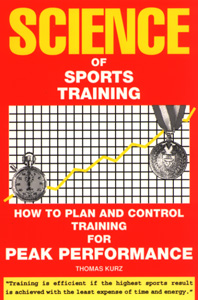by Thomas Kurz
Study this typical question on training carefully. It may contain elements that relate to questions of yours.
Question:
I received your video Secrets of Stretching a few days ago. I like it a lot and have also shared it with my head instructor at my karate studio. We have been slowly incorporating your methods into our karate classes. We began using your methods a few months ago after reading your book Stretching Scientifically. Many of the students are beginning to see remarkable results!
Since reading your book and viewing the video, I have decided to redo my workout routines. I am a martial artist and, therefore, my primary goal is to train in order to improve my martial arts skills, flexibility, speed, and endurance. I am 35 years old and am in above average condition for someone my age. I have worked out all my life. I also would like to maintain my muscle mass. (I’m not BIG, but I do have good muscle tone and would like to continue working with weights in order to keep my tone.) I am 5’ 10″ and 170 lbs. If I don’t work my upper body I will lose weight and be pretty scrawny looking, especially with all the other exercising I do.
So, even though I want to develop a workout that will improve my karate skills and flexibility, I also want to maintain and even improve my muscle mass in my upper body.
Here is what I have come up with:
Day 1 & 6: Technique/Speed
1. Dynamic Stretching A.M. & P.M.
2. Techniques & kicking drills
3. Sparring
Day 2 & 5: Strength
I have listed the exercises in the order
I do them. What do you think?
1. Dynamic Stretching A.M.
2. Warm-up
3. Bench Press/Dynamic leg stretches
4. Chest Flys/Hamstring curls
5. Military Press/Leg extensions
6. Bicep Curls/Squats
7. Dips/Deadlifts
8. Chin ups/Adductor flys
9. Crunches
10. Back extensions (machine)
11. Isometric stretches (arms, side split, front split)
12. Relaxed stretches
Day 3: Aerobics
1. Jump rope
2. Running/Sprints
3. Bike
4. Relaxed stretching
Day 4: OFF
Answer:
Both the video Secrets of Stretching and the book Stretching Scientifically explain how to schedule workouts, but you managed to miss it. Here is your weekly schedule:
Day 1 Technique/Speed
Day 2 Strength
Day 3 Aerobics
Day 4 OFF
Day 5 Strength
Day 6 Technique/Speed
Day 7 ?
Your Technique or Speed workout should precede your Strength or Endurance workout, a Strength workout should precede any Endurance workout, which should be followed by a day of complete rest or active rest, i.e., easy, fun activity. Don’t do a Technique or Speed workout on the day immediately following either an exhausting Strength or an exhausting Endurance workout, and don’t do Strength after an exhausting Endurance workout because such sequences of efforts lead to overtraining.
In single workouts don’t work on endurance before any other ability with the exception of static passive flexibility, which is developed by relaxed stretches. With exception of your warm-up, the intensity of your efforts should diminish as the workout progresses. Study Science of Sports Training for an in-depth explanation of why the same exercises give different results depending on their sequence in a workout and in the weekly sequence of workouts.
Regarding your strength exercises, I suggest that, instead of leg curls and extensions, you do more squats and deadlifts since they are better for your knees. By doing the deadlifts before adductor exercises, and abdomen crunches before back extensions, you break the rule of never fatiguing stabilizers—in this instance, abdomen muscles, which stabilize your back, or your back, which stabilizes your legs—before prime movers.
(More about this workout in the next article)
Resources for Further Study
Flexibility Express: Flexibility and Functional Strength in No Time

This easy-to-follow DVD offers a proven method of increasing your range of motion while increasing your strength—whatever your age or flexibility level.
You will learn innovative functional exercise progressions from weighted squats to splits and back bridges. Each exercise will build your muscles while increasing your flexibility, saving both your time and energy. The saved time and energy then can be used for more and better practice of your skills.
Science of Sports Training: How to Plan and Control Training for Peak Performance

This comprehensive text delves deeply into topics such as speeding up recovery, using time- and energy-efficient training methods, avoiding overtraining and injuries, applying proven methods of training to specific sports, and maintaining a high level of condition and skills for years. You will learn ways to plan and control training for each workout, over a span of years.
Secrets of Stretching: Exercises for the Lower Body

This DVD features an introduction to general conditioning and follows that with four exercise routines—one for beginners, one for intermediate, and two for advanced athletes. Viewers will learn plenty of how-tos. The focus is on flexibility and strength training.
If you have any questions on training you can post them at Stadion’s Sports and Martial Arts Training Discussion Forum